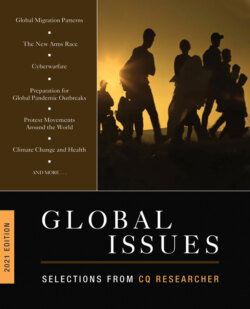Читать книгу Global Issues 2021 Edition - Группа авторов - Страница 81
Cracks Appear
ОглавлениеThose differences opened the first cracks in the arms control edifice. In June 2002, President George W. Bush, the son of the former president, withdrew from the Anti-Ballistic Missile Treaty Nixon had signed 30 years earlier, arguing that it limited U.S. ability to deploy missile defenses against rogue states. Russia’s new president, Vladimir Putin, strongly opposed the move, and in response, he also pulled out of the treaty, preventing it from taking effect.52
Tensions between Washington and Moscow escalated in 2007 when Bush announced plans to base anti-missile batteries in Poland and the Czech Republic, former Soviet-controlled Warsaw Pact countries that joined NATO after the Soviet Union’s demise. Bush maintained the missiles were needed to defend NATO allies against Iran’s missiles. But Putin saw them as anti-missile systems that could potentially be turned against Russia, blunting its nuclear arsenal.
U.S.-Russia relations improved after President Barack Obama took office in 2009. Eager to enhance cooperation, Obama announced he would scrap Bush’s plan for the Eastern European anti-missile sites and rely instead on the anti-missile systems aboard U.S. Navy warships.
The following year, Obama and Russian President Dmitry Medvedev signed New START, capping each country’s deployed nuclear warheads at 1,550 and its long-range delivery systems at 700. Like the previous U.S.-Russia treaties, New START included extensive verification procedures, providing transparency for both sides.53
In 2012, in another major nonproliferation effort, the United States and five other world powers began negotiating with Iran to halt its nuclear program, which many experts suspected was close to developing a nuclear bomb. In 2015, Tehran agreed to curtail its nuclear program in return for relief from international sanctions that had hobbled Iran’s economy.
Israel and its supporters in Congress condemned the deal, arguing that once key provisions expired after 10 years, Iran would be free to resume its weapons development. In his 2016 campaign for the presidency, Republican nominee Trump echoed those allegations, vowing if elected to withdraw from the Iran deal and negotiate a tougher accord permanently halting Iran’s nuclear and ballistic missile programs and ending its support for proxy military forces across the Middle East.
After winning the 2016 election, Trump turned his attention to North Korea, which was testing its nuclear weapons and long-range ballistic missiles capable of reaching the United States. Trump and North Korean leader Kim taunted each other with personal insults and threats.
In early 2018, the Pentagon released its updated “Nuclear Posture Review,” detailing the administration’s plans to modernize the nation’s nuclear arsenal and presenting limited tactical nuclear war as a viable battlefield strategy.54
On May 8, that year, Trump made good on his promise to withdraw from the Iran deal. Six months later, he reimposed crippling sanctions on the Islamic Republic and gave its leaders a stark choice: sign a tougher accord or watch Iran’s economy collapse. A defiant Iran refused and slowly reactivated its nuclear program.
In June of that year, Trump stunned arms control advocates and defense hawks by becoming the first sitting U.S. president to meet with a North Korean leader. Gambling that their personal diplomacy could sweep away decades of hostility and distrust, Trump and Kim held talks in Singapore and agreed to begin negotiations toward denuclearization of the Korean Peninsula.55
Meeting Kim for a second time in Hanoi in February 2019, Trump abruptly walked out of their summit after rejecting what U.S. officials said was the North Korean leader’s demand for relief from all U.S. sanctions in return for dismantling his main nuclear facility at Yongbyon. North Korea said it had asked for a partial lifting of sanctions.56
Last August, the two leaders met a third time, in the Demilitarized Zone between the two Koreas, and Trump even stepped briefly into North Korean territory—another first for a U.S. president. But their differences remained over how negotiations should proceed. North Korea experts say Kim wanted a step-by-step process in which the United States would reward North Korea’s gradual denuclearization with gradual sanctions relief and the removal of U.S. nuclear forces from the region. On the advice of his hawkish advisers, Trump insisted North Korea first surrender all of its nuclear and ballistic missile programs before the United States would provide any sanctions relief.
Arms control withered further last August when Trump withdrew from the Intermediate-Range Nuclear Forces Treaty with Russia. Like Obama before him, he accused Russia of covertly developing and deploying a banned intermediate-range cruise missile that could threaten both Europe and Asia, a charge Russia denied. Congress later authorized $10 million for tactical nuclear warheads to be mounted on intermediate-range ballistic missiles capable of reaching Russia after being launched from submarines in the region.57
The Defense and Energy appropriations bills signed into law in December provided the Trump administration with $30.8 billion to maintain and modernize the military’s nuclear arsenal and to pay for new nuclear-armed missiles, missile-launching submarines and long-range bombers.58
In what arms control advocates considered a hopeful sign, Putin announced late last year that he was ready to extend New START until 2026. Trump, however, refused to commit to its extension, citing his preference for a treaty that would include China.
In the end, 2019 came to a close with the future of New START, North Korea’s denuclearization and Iran’s nuclear program under clouds of uncertainty.
